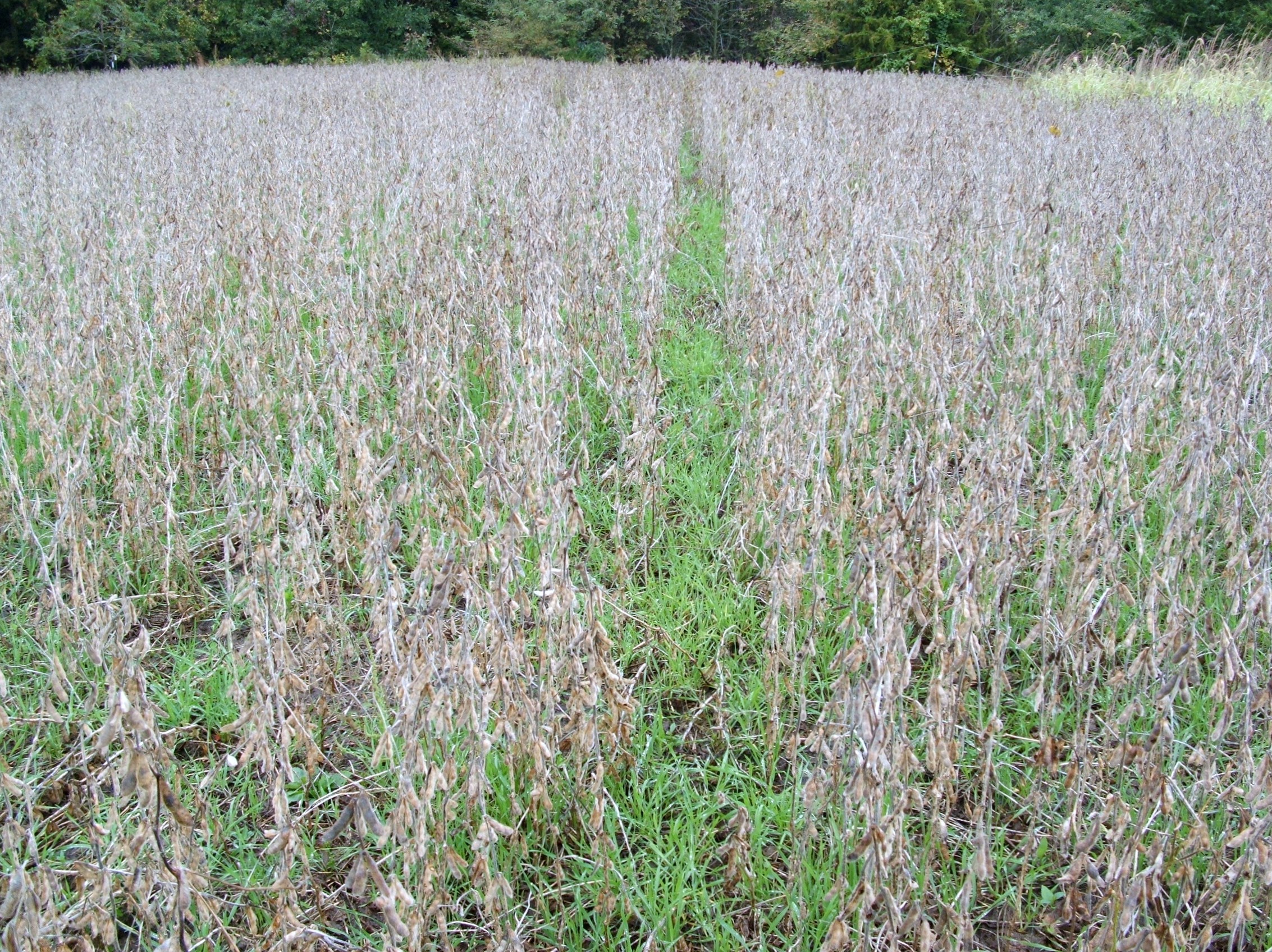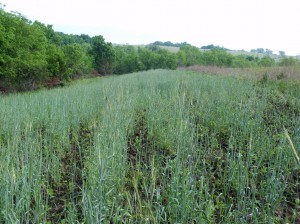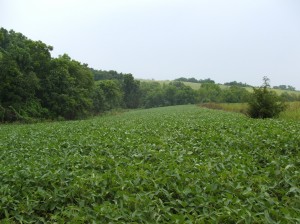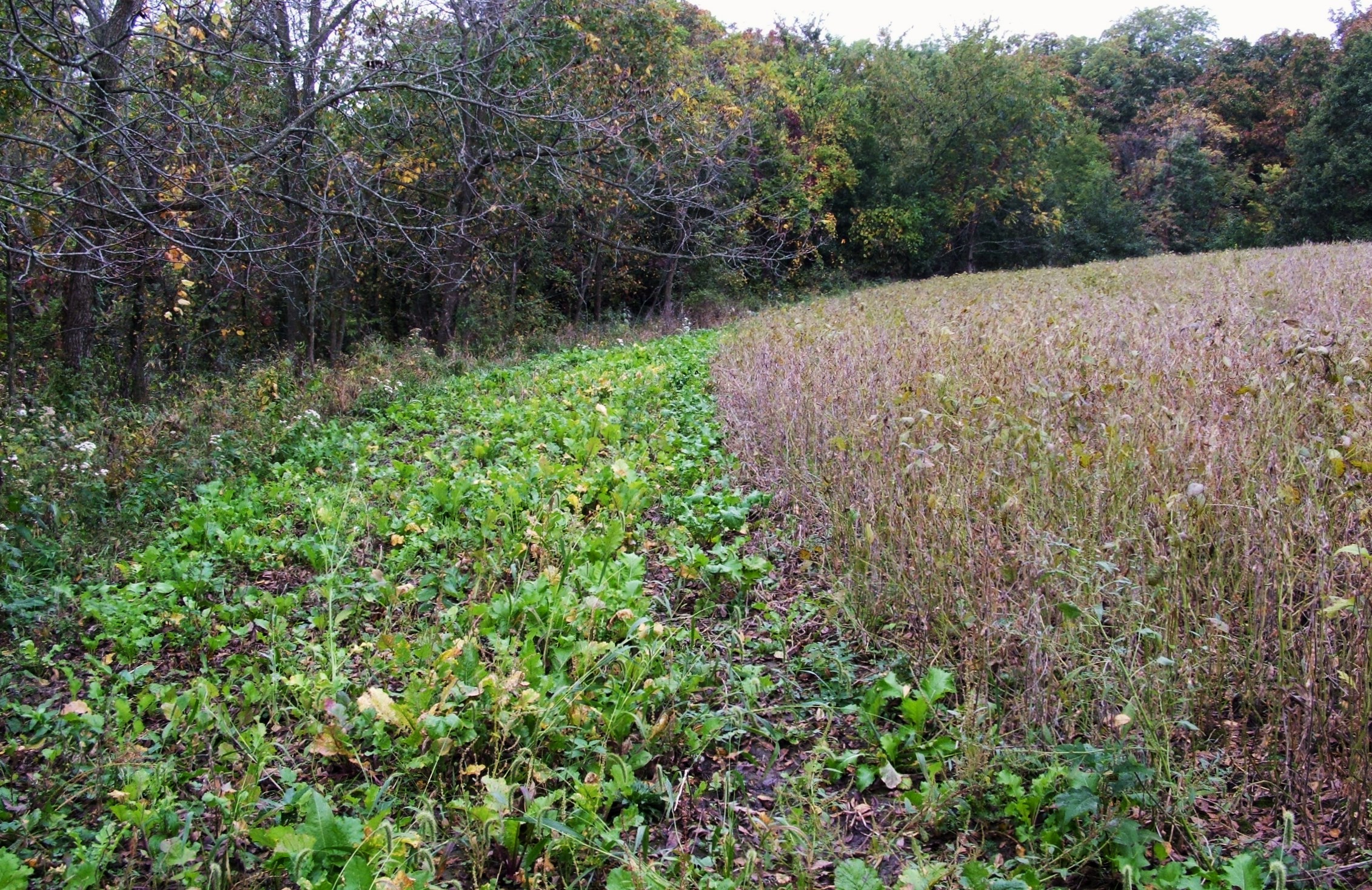April 2015-Planning the Year’s Food Plots
Introduction–I guess there may be other reasons to plant a food plot. It’s fun. When done right they look really good and make for good pictures to send to your buddies. They build our confidence and give us something to do outside of hunting season. But when I plant food plots there are really two reasons…to manipulate or persuade deer to move in directions or areas I want them to; or to attract and hold deer on my farm during hunting season so it is easier to hunt them.
In either case, my goal is to plant varieties of food sources that are the most attractive to deer during October through early January. In my opinion, the location of a food plot is as important (I would strongly argue more important) than the actual seed or plant in it. But, for the purposes of this article, I am going to concentrate on my experiences with food plot varieties. And before I even begin delving into varieties, let me throw one very strong opinion I have at you. Food plot attractiveness is always relative to what is available to the deer at the time! This is very important to understand. A food plot variety in one area might be a deer magnet during November…a mile down the road not so much. So when you compare food plot attractiveness you always need to consider what is available. I say this and stress it so much because hunters spend a lot of time and money (investment) on food plots. Many times they get their ideas from a buddy or hunting show. In each case, a hunter may do everything right and still not draw deer to a food plot. In most cases, it’s because a different more preferred food source is available at the time and in the area.
I have never in my life had the luxury of hunting out of the back door of my home. At least not once I started targeting mature bucks. So I have formed my opinions on food plots somewhat on their ease of growing and maintaining. Time is something I have never had too much of. Spare time that is. Therefore, I want to be upfront that my thoughts can be tilted to this consideration. I think many hunters fall into this category as well. Even if you are hunting right out back, I haven’t spoken with too many hunters that complain about having too much time. And most hunters don’t have unlimited budgets either. The time and money you spend on food plots is an investment into your hunting season. Your return on that investment can be measured in how well those food plots attract and hold deer on your property making it easier and more enjoyable to hunt.
The Hype! Oh yes…the hype around food plots is relentless. Every manufacturer is competing for your attention and money. But food plot seed has really been around forever. Corn, soybeans, cereal grains like oats and rye, brassicas, clovers, milo, alfalfa, and the list goes on have been around for ages. Agricultural seed suppliers have been manipulating genetics and coming up with better seeds for a long time. And, they’ve spent a lot of money doing it. Food plot seed is the same stuff. In many cases, food plot seed suppliers do a service in mixing and packaging seeds that better fit a hunter’s needs…but for the most part the seed itself is all the same. There’s nothing wrong with buying marketed food plot seed…just understand there is no miracle plot or secret seed that has a corner on the market or the deer’s appetite.
What to Plant?
Remembering that food plot attractiveness is relative to what is available, it is always in our best interest to make sure we have preferred food sources in our food plots. That’s just the way it is. I don’t have any surprises to share with you. I don’t have any new or earth shattering product to share. But what I do have is an honest take on what works best for most situations; what will make your food plots attract and hold deer…without the hype.
Interior Food Plots-Interior food plots are small plots inside the timber. They can only be planted in a green food source because plots like soybeans and corn will never survive aggressive feeding from the deer on these small plots. Most of the time I will plant an annual mix each and every year in these plots. My favorite blend for this plot is a blend of winter hardy cereal grains mixed with brassicas. The location of these plots is what draws the deer to them…so all we really have to do is make sure we have something green in there and something that will last. The best annual plot you can plant for this is a blend of winter rye, forage turnips, and rape. Winter rye will grow in just about any environment and stays green all winter. Long after most other green plants have frozen off or gone dormant, winter rye will stay green. Forage turnips produce tons of quality forage and some varieties are also frost tolerant. Rape is a very fast growing brassica that is extremely frost tolerant. My favorite fall planted blend for interior plots—25 to 30lbs/acre winter rye, 3lbs/acre appin turnips, and 3lbs/acre dwarf essex rape. This blend will cost you about $30/acre when buying bulk agriculture seed or as much as 3 times this if buying marketed food plot seed. If buying marketed food plot seed look for blends containing these varieties. Craigslist is a good place to buy bulk winter rye direct from a farmer! A fall planted annual is also the plot of choice for poor soils.
If you want to establish a perennial clover plot as your interior plot, my favorite blend for a first year fall planting is 25lbs/acre winter rye, 3lbs/acre appin turnips, and 5lbs/acre of a white clover like Alice, Ladino, or Jumbo Ladino. The winter rye and appin turnips will give you a great first year fall food plot. The clover will germinate in the fall and establish itself. The next spring the clover will explode and take over the plot. This is a great way of establishing a clover perennial as an interior plot. Cost for the blend is about $50-$60/acre if buying bulk agriculture seed.
Small Exterior Plots–Once you exit the timber and get into open ground, your choices for food plots get a little bigger. You have some options between a green food plot and possibly planting a grain plot like soybeans. There are so many scenarios to cover…but I’ll cover my favorite and best setup that I’ve been using and repeating for many years. It’s become a staple for me in my food plots…it makes sense, draws deer all year especially during hunting season, is easy to plant and grow, is cost effective, is great for weed control, is adaptable in wet and dry years, and it can all be done with minimal equipment.

Here, winter rye was over-seeded into standing beans. Once the beans are consumed, the winter rye will take over as the preferred food source. This plot is about ½ acre.
A small exterior plot of about a half-acre isolated from other Ag fields will most likely get a lot of pressure from the local deer herd. A half-acre is starting to get on the larger side (although still relatively small). If this plot is isolated from other Ag food sources and near cover, you probably still cannot plant a soybean plot…and definitely not corn. However, my favorite small exterior plot still involves soybeans. I start out planting soybeans on these small exterior plots knowing full well they will not reach maturity. Here’s how this works. First, in the spring I will plant the entire plot in soybeans at a rate of 1.5 bags/acre of roundup ready beans. I plant the cheapest early maturing roundup ready beans I can get my hands on. The soybeans offer a great summer plot and also allow me to spray them with glysophate (roundup) for superior weed control. In mid-summer, around the end of July or so and right before a rain, I till under the edges of the plot that have seen the most pressure and plant a brassica that is known for bulb production like purple top turnips. By the end of summer, the remaining soybeans are probably near their end because of heavy feeding by the local deer herd. If they are completely wiped out, I will till them under and plant the winter rye/appin turnip/essex rape blend I use in my interior plots. If there are still some beans left, I will simply over seed the beans (broadcast the seed over the top) the same winter rye/appin turnip/essex rape blend. I repeat the process each year—spring soybeans—bulb turnips around the edges mid-summer—winter rye/appin turnips/essex rape in late summer/early fall over the remaining beans. This process provides a great year round food source that peaks its attractiveness during the hunting season. I plant the winter rye/appin turnips/essex rape blend at 25, 3, and 3lbs/acre respectively. The purple top turnips planted around the edge are planted at a rate of 5lbs/acre. The great thing about this setup—after the first year this becomes a perpetual food plot providing food every day of the year. This plot will cost you about $125/acre each year (using bulk Ag seed).


In the spring, winter rye that was planted last fall will come up strong. You can sow your soybeans directly into the winter rye by discing in the seed. The winter rye will stay growing and act as a cover crop protecting the beans as in the picture on the left. After spraying, the soybeans will explode and will hopefully look like the picture on the right. This plot is about 1 acre.
Larger Exterior Plots-Not everyone has the ability to plant larger food plots. With today’s crop rental rates, many hunters are not afforded the opportunity to turn tillable ground into food plots. And, planting more than a half-acre here and there requires more time, money, and in many cases equipment. But, if you have the ability to do it, these larger plots can really separate a nice farm from a great farm because of their ability to provide more tons of preferred food sources that can last into winter each year. Sure, winter rye and brassica bulbs make a great plot…and they will make it late into the season. But, put standing soybeans or corn next to winter rye and rotting brassica bulbs and I can tell you where my tree stand or muzzleloader blind will be.
I want to start with corn before I get into what my favorite all around plot is for larger exterior plots. Corn is a great late season attractant for deer. I can tell you stories about hunting standing corn in late December and early January. But in each case, the standing corn has been un-harvested agricultural corn. Corn is a tough food plot for most hunters…me included. It is costly to plant; as much as $350/acre when done right. It requires a decent amount of real estate to prevent the deer from annihilating it early in the silk stage which is also costly. And, when compared to other food plots it is not all that preferred until very late in the hunting season. For these reasons, I don’t recommend corn unless you have a big budget, excess tillable acres, and other areas for other plots.

An example of brassicas (in this case turnips) planted on the edge of a small exterior plot originally planted in soybeans. Small exterior plot of about ½ acre.
So, once again, I find myself making a pitch for soybeans. Soybeans will work and grow to maturity in as little as half an acre if butted up against agricultural soybeans. Many times however, our food plots are located back off Ag fields near timber and cover. In most cases then, it requires at least an acre, and more like two or more to get a good stand of beans to grow and reach maturity with pods. In areas with high deer densities or little to no agricultural food sources you may need as much as 5 acres to get a good viable stand of beans. Soybeans will cost you about $125/acre each year. When planting soybeans in larger exterior plots I prefer going with a maturity class that pushes the limit for the area I’m in. For southern Iowa, I’ll plant a category IV or even early category V soybean. Most farmers in the area are planting earlier beans. I do this because it can extend the green phase of the soybeans later into the year and helps with preventing soybean shatter. Don’t confuse this with planting late maturing forage soybeans…which won’t provide you with a viable food plot once the freezing temperatures come. And one last thing, even with these larger soybean plots you can still sow in brassicas on the edges and over-seed the entire plot with winter rye which will extend the plot beyond when the beans are consumed.
In Review-I haven’t covered every scenario and every potential food plot. I actually intended to when starting this article. But I kept going back in my mind to all the times I’ve tried other plots…and why I’ve always come back to what has worked. What I covered here in this article is what has worked for me in the past and is still working today with the highest return on my investment. Year in and year out, these three food plots yield me the biggest results and I seldom stray from these plot plantings. Whitetails 365 is dedicated to the weekend hunter with a time and money budget. These food plot ideas are affordable, attractive to the local deer herd, and easy to plant offering a solid foundation for any food plotter.
This April, on my farm, I will be preparing for spring grain planting and ordering seed. I will also be installing an electric game fence to protect some of my exterior soybean plots so that they last longer into the season.
In May’s issue, I will be covering spring planting techniques for soybeans, corn, and spring planted perennials like clover or alfalfa and the implements to make it work. I will also cover why I use roundup ready seeds when planting grain crops. I will also cover why I prefer soybeans as my crop of choice when it comes to grain crops and some advanced tactics using soybeans.
